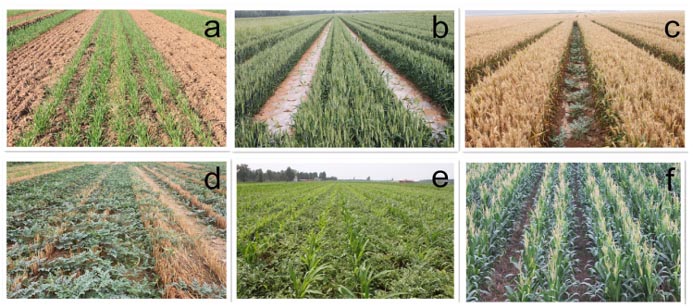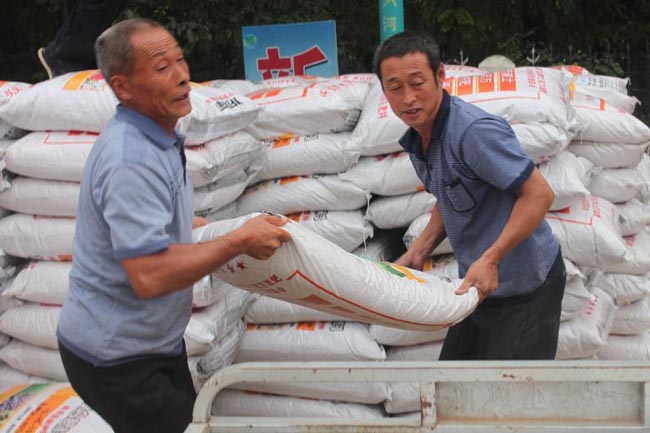Dear everyone, here is Houlaoying Science & Technology Backyard (STB) in Quzhou county, Heibei province on the North China Plain.

Houlaoying STB in 2010

Houlaoying STB in 2016 (same place in 2010)
In the first year, when built this backyard in April 2010, three students-Chengdong Huang (a PhD student in China Agricultural University), Baoshen Li (a Msc. Student in Northwest A&F University), Aili Wang (Msc. In Yangzhou University), and associate professor Quanqing Liu from Hebei Academy of Agriculture and Forestry Sciences. Since 2011, only Chengdong Huang and Quanqing Liu worked in STB, and Chengdong Huang got his PhD degree in 2015 with research topic of wheat-maize/watermelon intercropping nutrient integrated management, and a Msc. student Haipeng Li joined in STB in 2013, got his Msc. degree in 2016, another new master student joins in STB in 2016, and he will work in STB for his Msc. degree in the next three years.
Before we came here, farmers here were very clever, they built the wheat- maize/watermelon intercropping system, it was developed from wheat-maize double cropping by local farmers. According to our findings, the economic profit per hectare is 2328 US dollars higher than wheat-maize double cropping system, so farmers very like it.
In Mid-October during sowing wheat, farmers block the middle five or six holes of sowing machine. Then in May the next year, farmers sow or transplant watermelon on the empty land. A month later, farmers harvest wheat by combine harvester. Then sow maize between watermelon strip and wheat strip. Watermelon is harvested from late July to early August. Maize is harvested in October.

Fig. Field view of wheat-maize/watermelon intercropping system in Houlaoying village. (a) wheat emergence in the end of October, (b) watermelon transplanting and wheat flowering in mid-May, (c) wheat maturity in mid-June, (d) watermelon growth alone after wheat harvest, (e) watermelon harvest from late July to early August, (f) maize growth alone after watermelon harvest and harvested in mid-October.
Table 1. Grain and fruit yield (t ha-1) and partial Land Equivalent Ratios (pLER) of double cropping and intercropping systems.

From table 1, we can see that wheat-maize/watermelon intercropping has a 23% lower yield as compared to wheat-maize double cropping in grain yield production. The relative yield of wheat and maize grain in intercropping was 1.77, higher than its relative density with 1.58 (0.58 for wheat and 1.00 for maize). Meanwhile, an additional 30 tons of watermelon fruit produced in intercropping system and can get more money for smallholder farmers, that’s would be very important for those farmers that cannot go outside for off-farm work, and could reduce village poverty in a certain.
When we first come here, we knew nothing that we could do for farmers, because our specialties are all plant nutrition, we knew nothing about watermelon, just knew how to eat watermelon. So how we can be a small expert rapidly and did something for farmers?
First step, we become farmers, and learn from farmers. Farmers have about more than 20 year’s practical experience for growing watermelon, so they know too much thing about watermelon. We learned from farmers, investigated how farmers manage their own field, and wrote down farmers’ management practices, and then combined with our knowledge and technologies for high yield and high efficiency. Then formed into a high yield and high efficiency technical specification, and pasted it on the wall, so if farmers have some questions they can come here anytime, and know how to scientific manage their own fields.

Investigation of field management practices

Technical guidance for scientific management of wheat-maize/watermelon intercropping system pasted on the wall.

Discuss with farmer about watermelon disease in the field

Farmer come to STB and ask how to properly use pesticide
Second step, unreasonable fertilization, watermelon farmers they prefer to using nitrogen (N) fertilizer for a higher yield and more income from watermelon production, while too much N fertilization resulted in lower quality of watermelon fruit because reduced total sugar content of watermelon fruit. So we launched soil testing and formulated fertilization, during last six years, we helped farmers in STB to order fertilizer more than 500 tons since 2010, and saved money for farmers about 50000 dollars. Also the quality of watermelon is better than before.

Soil sampling

Allocating fertilizer to farmers

Watermelon harvest
Thirdly, the biggest plant disease for watermelon is cropping cautious obstacles - Fusarium wilt (soil-borne disease), farmers know using grafting technology can solve this big problem, but it was difficult for them to graft, because grafting just like a surgical operation, farmers don’t think it could survival that a scion of watermelon seedling (the aboveground part of watermelon) grafted with stock of another non-watermelon (root of pumpkin, gourd and so on). In this context, how to change farmers’ rooted notions, and challenge this problem? We built a small greenhouse where we started to graft. During grafting period, we invited and cultivated farmers how to graft, few days later, most grafting watermelon survived, and the survival rate was more than 85%. And then farmers knew it was so easy and accepted grafting technology.

Students and farmers were building a small greenhouse for watermelon grafting

The greenhouse for watermelon grafting in STB

Teaching farmers how to graft watermelon

Give the grafted watermelon seedling to local farmers

Grafted watermelon seedling


The plant of self-root (left) and grafted (right) watermelon